Isabella Bradford's Blog, page 49
September 17, 2016
Breakfast Links: Week of September 12, 2016
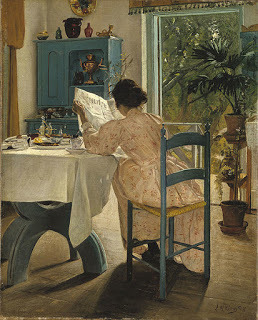 Breakfast Links are served - our weekly round-up of fav links to other web sites, articles, blogs, and images via Twitter.
Breakfast Links are served - our weekly round-up of fav links to other web sites, articles, blogs, and images via Twitter.• Is this the key to Alexander Hamilton's secret correspondence ?
• The physics of Rapunzel's hair : could a man really use it to climb up? Apparently yes.
• A familiar part of Georgian travel : falling off your horse.
• French kissing to lesbian orgies: the origins of the myth of the debauched French court .
• Image: From the Lady's Magazine, July 1797: "Rules to be observed at City Feasts , especially Parochial Ones" - and perhaps at BBQs, too.
• "Gymnasticks" and dumbbells: exercise in 17th-18thc Britain.
• The weathervanes of Old London.
• Ring for a bride, made from shard of glass that nearly blinded a WWI tank commander in battle.
• Image: Already a tourist attraction: Philadelphia house where Jefferson wrote Declaration of Independence, shown in an 1855 photo.
• Are these seven pigtails from the infamous mutineers of the Bounty?
• Great rooms in children's literature.
• "A most lamented princesse ": a 17thc English princess at Versailles.
• Uncovering a different side of Bath .
• The 18thc man with (supposedly) 87 children – and only one wife.
• Image: A Medusa mosaic, 2nd-3rdc AD from the Archaeological Museum of Tarragona.
• The tragedy of early 20thc beauty, model, and actress Audrey Munson .
• When fashion becomes a form of protest .
• British female felons in the 18thc.
• The newest historical American Girl doll has Motown swagger.
• General George Washington , hairdresser.
• Image: Oh, the Illustrated Police News, 1895: " Pinching girls' legs his mania." Story here .
• One hundred and fifty-one years after the last shot was fired, a Civil War pension is still being paid by the U.S. government to the daughter of a veteran.
• Criss-Cross Spelling Slip s: sold as an educational game in the 1880s.
• "Gone for a solider ": but the 19thc British Army wasn't for everyone.
• Image: Just for fun: arguably the best photo and caption on Wikipedia.
Hungry for more? Follow us on Twitter @2nerdyhistgirls for fresh updates daily.
Above: At Breakfast by Laurits Andersen Ring. Private collection.
Published on September 17, 2016 15:00
September 15, 2016
Friday Video: The President's Tailor
Isabella reporting,
While Loretta and I were on our break, Labor Day may have slipped by, but we haven't forgotten it. A holiday in celebration of the American worker is too wonderful to overlook, and today's video is the perfect tribute. Martin Greenfield is a master tailor who has made suits for American presidents from Eisenhower to Obama. Immigrating to this country as an orphaned teenager in 1947, he's justifiably proud of his craftsmanship and all he has achieved, and he's clearly prouder still to be an American.
But Mr. Greenfield's story is filled with tragedy as well. Because he and his family were Jews, they were imprisoned by the Nazis in the concentration camps at Auschwitz. He was the only one of his family to survive, and as he says in this video, he continues to grieve for them over seventy years later. In this American election year, when racist rhetoric and hate-crimes against those who are different are on the rise, and the Alt-Right movement has brazenly appropriated the symbols and philosophies of Nazi Germany, we all need to be reminded of the hard lessons that came from the suffering of the past, and make sure those dark days never return.
If you received this post via email, you may be seeing an empty space or black box where the video should be. Please click here to watch the video.
Published on September 15, 2016 21:00
September 14, 2016
Pulvermacher's Hydro-Electric Chains to Cure Whatever Ails You
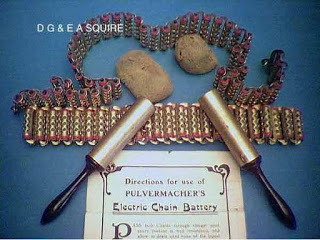 Pulvermacher's Electric Chain
Loretta reports:
Pulvermacher's Electric Chain
Loretta reports:My vacation reading included Claire Tomalin’s Charles Dickens: A Life . You’d think, after all this time, all the bios, all the scholarly papers, there’s nothing new to learn about Dickens. Au contraire.
Maybe I overlooked it elsewhere, but, among other things, I discovered that Dickens’s health was worse than I'd supposed, and he suffered from gout (which he pretended was something else—there was a lot of fiction in his life as well as his books). And to treat his painful foot, on the night before he died, he ordered “a ‘voltaic band,’ a type of electric chain that had become a fashionable all-purpose cure, recommended to him by the actress Mrs. Bancroft and supplied by Isaac Pulvermacher, Medical Battery Maker.”
And yes, of course I tracked the thing down for our readers’ edification.
You can read about it in this detailed pamphlet . And this pamphlet explains all the ailments it supposedly cures. And you can read the the Wikipedia overview, with illustrations. And Hand-Book of Natural Philosophy 1856 explains some more here .
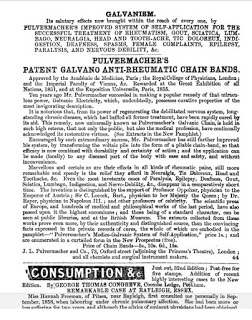 Puvermacher's advertisement 1859
Puvermacher's advertisement 1859
Please note the impressive list in the ad, of those endorsing the device.
Clicking on the image will enlarge it. Clicking on the caption will take you to the source, where you can learn more and enlarge images as needed.
Published on September 14, 2016 21:30
September 12, 2016
An 18thc Dress Becomes a 19thc Costume for Charades
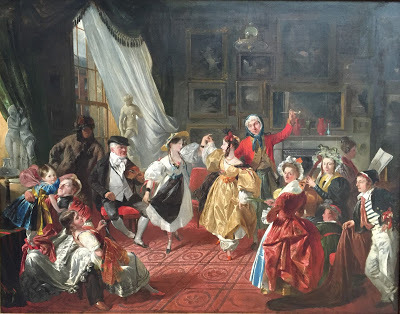 Isabella reporting,
Isabella reporting,For people like me who love 18thc clothing, the 19thc can be a very dark period. For an era that has a reputation for being grim and dour, the Victorians seized any excuse to dress up in fancy dress. Costume balls, masquerades, pageants, amateur charades and pantomimes after supper were all the rage, and they loved, loved, loved the gorgeous silks and velvets of the Georgians.
While some of the most elaborate fancy-dress outfits worn by the upper classes were created to order by designers like Charles Frederick Worth, the majority of Englishmen and women would simply ransack the attic for a good costume. If great-grandmother's dress or great-grandfather's coat wasn't considered worthy of remaking into something modern, it became fair game for dress-up.
Nor were the clothes treated with much respect. The idea of preserving the past through the material culture of clothing is a relatively new idea. Old clothes were simply old clothes, and it was more important - and fun - to let everyone amuse themselves with makeshift fancy dress, from adults to children. Some 18thc clothes, too, were donated to theatrical companies, where they suffered the additional indignities of being smeared with stage make-up and worn under hot lights. Still other clothes wound up in the wardrobes of artist's studios, ready to dress a model for a painting with an historical theme.
Modern costume curators all have horror stories of how once-glorious Georgian dresses and suits in their collections were battered and stained and remade until they became only faded, tattered shades of their former selves: a scrap of embroidered silk here, or a jewel-studded button there. But until I saw this painting last month while visiting the RISDMuseum, I'd never witnessed the very act of Victorian costume-crime.
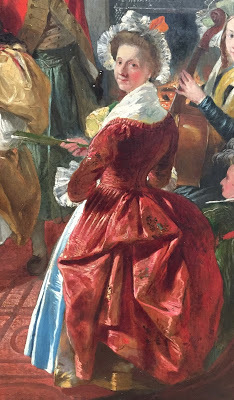
A Game of Charades, above (click on the image to enlarge), was painted by the popular historical and genre artist Edward Matthew Ward. A lively family group is amusing itself with charades in the parlor, and the improvised costumes include a sailor, some sort of rough frontiersman, and a gypsy. Of course there's a guy in drag, too, with a cap and kerchief on his head, because there always is.
I'm not quite sure about the clothes of the two young women dancing together, and the two women musicians. The museum dates the painting at c1840, which would make their dresses with the enormous sleeves about ten or fifteen years out of date. Are those sleeves far enough from current fashion that the dresses would have already become ripe for ridicule and costume - much the way today that people invited to parties with a 1980s theme will wear huge shoulder pads? The yellow dress seems to be worn with some ankle-length bloomers plus "exotic" slippers, which makes me think it's become a costume. Or are the young women not wearing costumes at all, but are simply a bit behind the current trends?
But it's the woman in the painting's foreground (and right) who really breaks my heart. She's wearing a gorgeous gown, petticoat, and apron from around 1775, complete with a ruffled cap that she likely found in the same trunk. The pale blue silk in that apron shimmers richly, and the petticoat that peeks out from beneath the gown looks like it might have gold threads. The rose silk of the gown is either a damask weave, or perhaps embroidered with flowers. This is still-beautiful clothing that must have been the height of fashion when new, and costly, too, yet by 1840 it's been relegated to charades, or perhaps to the artist's costume collection. What became of it all since then, I wonder?
Above: A Game of Charades, by Edward Matthew Ward, c1840, RISDMuseum.
Published on September 12, 2016 21:00
September 11, 2016
Fashions for September 1882
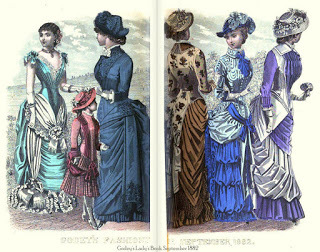 September 1882 Fashions
Loretta reports:
September 1882 Fashions
Loretta reports:C. Willett Cunnington, writing in 1937, had this to say about 1880s fashions, in English Women’s Clothing in the Nineteenth Century .
The fashions of the ‘80’s were more remote than those of any other decade from modern standards of taste. But if, on that account, we are pleased to call them ugly we only beg the question—not very important—which is the better taste. Their interest to us lies in their significance for they display an unusual amount of symbolism. Economic depression forcing many women to seek other careers than marriage, couple with increasing outdoor activities, produced fashions in which the ordinary devices of sex-attraction were absent. The tailor-made costume, for example, seemed to the older school repellently masculine. It was the first move towards a style signifying (unconsciously) that the wearer was engaged in some other pursuit than the capture of man. Even the evening dress, majestically ornate, avoided the cruder methods of allurement; the high neck for dinner wear, the minimum display of physical charms until eh close of the decade, and the preference for heavy materials, all were in keeping with the spirit of the period. The principle was strict, that beauty should make no passionate appeal. The epoch was, above all others, anti-anatomical.”
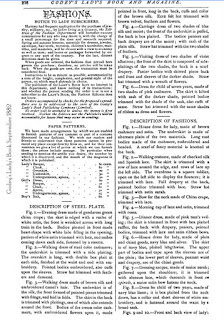 September 1882 descr
September 1882 descr
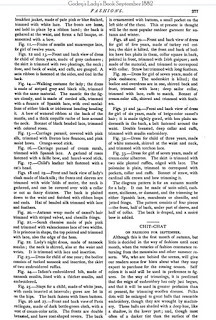 September 1882 descr
The author quotes a “contemporary’s” remark: “Women whose minds are occupied with other things tend toward simplicity in costume while those who are empty-handed and empty-headed oftenest appear in fantastic and gaudy garments.”
September 1882 descr
The author quotes a “contemporary’s” remark: “Women whose minds are occupied with other things tend toward simplicity in costume while those who are empty-handed and empty-headed oftenest appear in fantastic and gaudy garments.”Each era brings its own perspective on dress, of its own as well as earlier times. And I for one am not at all sure that “fantastic and gaudy garments” necessarily indicate stupidity or shallowness. For some people, extravagance in dress can be an expression of joie de vivre or an artistic statement, among other things.
Clicking on the image will enlarge it. Clicking on the caption will take you to the source, where you can learn more and enlarge images as needed.
Published on September 11, 2016 21:30
August 24, 2016
Gone Fishin'
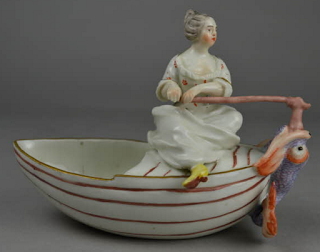 Isabella and Loretta reporting,
Isabella and Loretta reporting,It's nearly the end of August, and once again time for us to take our annual break from blogging, tweeting, pinning, 'gramming, and FB-ing to spend time away from our computers with friends, families, and a few good books. We hope you'll find some enjoyable ways of your own to spend these last days of summer, too.
See you again in September!
Above: Salt-cellar, made by Frankenthal Porcelain Factory, The British Museum.
Published on August 24, 2016 21:00
August 22, 2016
Bartholomew Fair in the Early 1800s
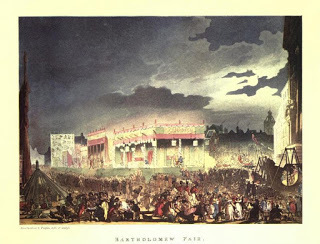 Bartholomew Fair
Loretta reports:
Bartholomew Fair
Loretta reports:Though Bartholomew Fair started out being celebrated on St. Bartholomew’s day, 24 August, calendar reform moved it to 3 September after 1752. It went on for another hundred years, until the Victorians banished it in the 1850s, maybe with just cause or maybe because ordinary people were having too much of a rollicking good time.
But as Ackermann’s Microcosm of London demonstrates, it was still going strong in 1808. I do love the description of it as “this British Saturnalia,” and yes, this is one of Rowlandson's livelier images for the book. He must have had a blast with it!
The annexed print is a spirited representation of this British Saturnalia. To be please in their own way, is the object of all. Some hugging, some fighting, others dancing: while many are enjoying the felicity of being borne along with the full stream of one mob, others are encountering all the dangers and vicissitudes of forcing their passage through another; while one votary of pleasure is feasting his delighted eyes with the martial port of Rolla, and the splendid habiliments of the Virgins of the Sun, another disciple of Epicurus is gratifying his palate with all the luxury of fired sausages, to which he is attracted by the alluring invitation of “Walk into my parlour!” —Microcosm of London Vol 1.(Since the Spitalfields Life blog always has superior images to what I can find in the public domain, I recommend you visit here , and enlarge.)
Along with the feasting and hugging and squeezing there were carnival rides as well as performers and other entertainments you can read about in Henry Morley’s Memoirs of Bartholomew Fair (first published in 1857).
One of the entertainers who intrigued me especially was the Fireproof Lady, but you may have your own favorites.
 Fireproof Lady
Fireproof Lady
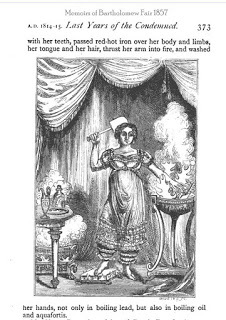 Fireproof Lady
Fireproof Lady
Clicking on the image will enlarge it. Clicking on the caption will take you to the source, where you can learn more and enlarge images as needed.
Published on August 22, 2016 21:30
August 21, 2016
A Beautiful Bed with (Perhaps) a Political Agenda, c.1805
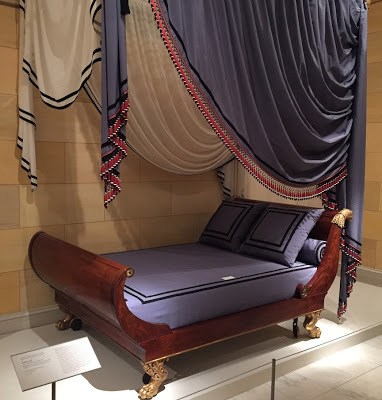 Isabella reporting,
Isabella reporting,Loretta has shared many examples (such as these here and here ) of furnishings from the pages of Ackermann's Repository, showing what was "on trend" for fashionable homes in early 19thc Great Britain.
I was reminded of those illustrations when I recently spotted the bed, left, in the Metropolitan Museum of Art. With its swooping curves, gleaming mahogany, ebony, and rosewood, brass inlay, and elaborate (reproduction) hangings, the bed could have been straight from the pages of Ackermann's. There's one difference, however. It wasn't made in London, but in New York.
According to the bed's placard:
"Following the Revolution, Americans took inspiration from the ancient empires of Greece and Rome in the establishment of a democratic republic. In turn, domestic interiors and furnishings began to resemble architecture and artifacts from classical antiquity. This bed's sweeping frame echoes the form of a Roman lectus (daybed) and the bronze plaque at the base bears the profile of a Roman magistrate or military officer."
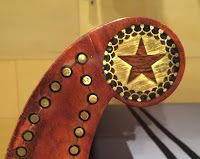
In other words, this bed wasn't just a stylish piece of furniture: it was making a patriotic statement. Eagles and stars appear throughout American design of the period, and combined with the ancient Roman design, this bed was a thorough expression of Federalist sensibilities.
Or perhaps not. Although it was made in New York, the maker was a Frenchman, Charles-Honoré Lannuier. One of the city's foremost furniture makers, Lannuier employed his Parisian cousin, Jean-Charles Cochois, around the time this bed was made. Cochois would have brought with him the latest in Parisian designs inspired by the newly-created French Empire of Napoleon Bonaparte. Napoleon, too, wanted to create a new country with all the trappings of ancient Rome, but of a Roman empire rather than a Roman republic. So are the aggressive eagles on this bed republican American eagles, or imperial French ones?
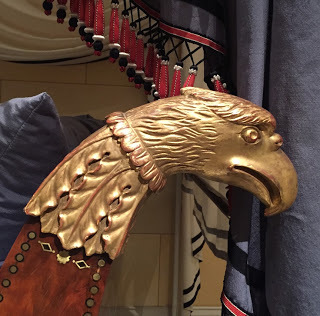
One more thought: to the early 19thc customer commissioning this bed, the political and bellicose overtones of its design would have been a selling point. Today's consumers, however, prefer their beds to be a bit less menacing. While this style of classically-inspired bed - without the eagles and inlay - is once again very popular, savvy modern manufacturers call them sleigh beds - conjuring up cozy images of fresh snow, warm blankets, and sleigh bells instead of stern Roman military officers plotting their next conquest.
Above: Bedstead, by Charles-Honoré Lannuier and Jean-Charles Cochois, c.1805-8. Metropolitan Museum of Art.
Photographs ©2016 Susan Holloway Scott.
Published on August 21, 2016 17:00
August 20, 2016
Breakfast Links: Week of August 15, 2016
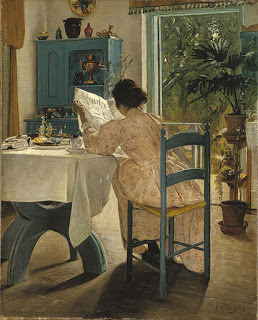 Breakfast Links are served - our weekly round-up of fav links to other web sites, articles, blogs, and images via Twitter.
Breakfast Links are served - our weekly round-up of fav links to other web sites, articles, blogs, and images via Twitter.• Three hellish places from London's past that you wouldn't want to visit.
• The bridges of Old London.
• A scandalous divorce: the two Mrs. Fenollosas.
• Where is King Henry VIII buried and why doesn't he have a tomb?
• DIY fashion continues to thrive at the McCall Pattern Company , founded in 1863.
• Image: Jane Austen finishes writing Persuasion on August 6, 1816 - and here's a page of the manuscript.
• "The pink of fashion ": Mrs. Andrew Hamilton visits SweetBriar in Philadelphia, 1818.
• The many loves of Henry Tufts , the original colonial bad boy.
• How left-handed penmanship contests tried to help Civil War veterans after amputations.
• Paris, city of lights, romance, and urinals .
• Image: 2000-year-old Greek mosaic floor accidentally discovered in Turkey (and it's a beauty.)
• Mayhew's street traders of London, 1851.
• Stunning interpretations of El Greco portraits created with yarn, a loom, and an algorithm .
• Countess Leonor D'Oeynhausen , an 18thc poet and intellectual possibly involved in espionage.
• 1926 meets 1776 at the Philadelphia Sesquicentennial .
• From the suffragettes to BLM: the unexpected ways that protestors have utilized fashion.
• Image: The 19thc Egyptian House in Penzance makes even the Brighton Pavilion look demure.
• The nostalgic glow of NYC's remaining historic neon signs .
• A short illustrated history of firefighting helmets .
• Occupational hazards: the maladies of early modern midwives .
• Who shot Edward Vyse? The Corn Law Riots of 1815.
• Image: A Victorian anti-drowning device .
• Bonded by love and liver: the story of conjoined twins Chang and Eng .
• How many of the signers of the Declaration of Independence were born in places other than the state they represented in the Continental Congress?
• We love a ducky story with a happy ending.
Hungry for more? Follow us on Twitter @2nerdyhistgirls for fresh updates daily.
Above: At Breakfast by Laurits Andersen Ring. Private collection.
Published on August 20, 2016 14:00
August 18, 2016
Friday Video: Listen to a Guitar Made by Antonio Stradivari in 1679
Isabella reporting,
Antonio Stradivari (1644-1737) is arguably the most famous maker of stringed instruments of all time time. The sound of his violins and cellos is considered magical, almost mystical, and experts have argued endlessly about what exactly makes them so special. Around 650 of his instruments are known to survive today; most of these are the legendary violins.
Much rarer still are guitars made by Stradivari. Only five still survive. Of those five, only this one remains playable. Known as the Sabionari, the guitar dates from 1679. Here Rolf Lislevand, a musician who specializes in performing early music, plays a tarantela by Spanish composer Santiago de Murcia (1673-1739.) What a wonderful way to begin the weekend!
If you received this post via email, you may be seeing an empty space or a black box where the video should be. Please click here to view the video.
Published on August 18, 2016 21:00



